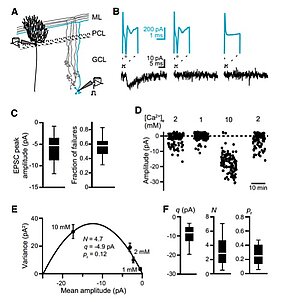Nanodomain coupling at an excitatory cortical synapse
01.01.2013Schmidt H, Brachtendorf S, Arendt O, Hallermann S, Ishiyama S, Bornschein G, Gall D,Schiffmann SN, Heckmann M, Eilers J (2013)
Current Biology 23:1-6
The coupling distance between presynaptic Ca2+ influx and the sensor for vesicular transmitter release determines speed and reliability of synaptic transmission [. Nanodomain coupling (<100 nm) favors fidelity and is employed by synapses specialized for escape reflexes and by inhibitory synapses involved in synchronizing fast network oscillations. Cortical glutamatergic synapses seem to forgo the benefits of tight coupling, yet quantitative detail is lacking. The reduced transmission
fidelity of loose coupling, however, raises the question whether it is indeed a general characteristic of cortical synapses. Here we analyzed excitatory parallel fiber to Purkinje cell synapses, major processing sites for sensory information and well suited for analysis because they typically harbor only a single active zone. We quantified the coupling distance by combining multiprobability fluctuation analyses, presynaptic Ca2+ imaging, and reactiondiffusion simulations in wild-type and calretinin-deficient mice. We found a coupling distance of <30 nm at these synapses, much shorter than at any other glutamatergic cortical synapse investigated to date. Our results suggest that nanodomain coupling is a general characteristic of conventional cortical synapses involved in high-frequency transmission, allowing for dense gray matter packing and cost-effective neurotransmission.


